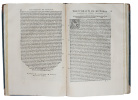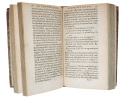6 books for « theophrastus theophr... »Edit
-
Century
16th (3)
18th (3)
-
Topics
Botany (1)
Philosophy (2)
Theophrastus (6)
De Historia plantarum Libri VIII, Et Decimi principium De Causis, siute generatione plantarum, Libri VI. Theodoro Gaza interprete. Cum eorum omnium quæ his Theophrasti libris continentur, indice. (2 Parts).
(Colophon: Basel, apud Andream Cratandrum, 1534). Folio. Nice hcalf from ab. 1750, richly gilt back, gilt title-label. Corners a bit bumped. Slightly rubbed. Woodcut printer's device to title and last leaf. (28),264,(2) pp. With many smaller and larger woodcut initials. Small stamp at lower corner of the first 2 leaves. Some, rather faint, dampstainings to first and last leaves, otherwise clean and with broad margins. Engraved book-plate inside front board (Bibliotheque du comte Le Moyne de Martigny).
Very scarce edition of Theophrastus' two main works. It is one of the earliest Latin editions of Gaza's esteemed translation, in reality it is the third printing of the first Latin edition (first issued 1483, then 1529 in 8vo, and now 1534) of the works which together constitute the foundation of scientific botany. By Linnaeus Theophrastus is called ""the father of Botany"". This edition comprises both botanical works, The History of Plants and The Causes of Plants, which have survived in their entirety and are the earliest books of this kind in world literature.""It is very strange that so much botanic knowledge should have been accumulated by the end of the fourth century and that so little, if anything, was added to it in ancient times. Theophrastos is not only the first botanic writer but also the greatest until Renaissance of the sixteenth century in Germany....The botany of Theophrastos and the zoölogy of Aristotle represents the climax of natural history in antiquity."" (Sarton in A History...Vol. I p. 558). ""No study of plants of such breadth and quality had previously been conceived: botany now first appears as a distinct science with a comprehensive yet clearly defined field of enquiry."" (A.G. Morton). - Stillwell No. 702 (Note) - Hunt No. 26 (listing the 1529-edition in 8vo) - Pritzel: 9189. - Not in Choulant, Handbuch der Bücherkunde für die Ältere Medicin.
Characteres. Recensuit animad versionibus illustravit atque Indicem Verborum adiecit Joh. Frider. Fischerus accessit Commentarius Isaaci Casauboni.
Coburg, Ioh. Caroli Findeisii, 1763. Contemp. full calf. Raised bands, titlelabel with gilt lettering. (56),166 pp. + Index and 240,(10) pp. A small stamp on titlepage. Internally clean and fine.
First edition of Fischer's excellent edition with Casaubon's commentaries.""The Commentary of Casaubon, with the useful observations of Gale and Needham - a copious and accurate index - and an excellent review of MSS, and previous editions, displaying every where great critical sucumen as well as just taste.""(Dibdin p.502).
"THEOPHRAST. -THEOPHRASTUS, THEOPHRASTOS, TEOFRAST, TEOFRASTOS.
Reference : 28328
(1561)
(Charakteres - Characters). Libellus continens notas atque descriptiones morum qvorvundam vitiosorium, conuersus in linguam Latinam & annotationibus illustratus a Leonharto Lycio. Ex uitio sapiens emendat suum. - [SKETCHING THE CHARACTER OF MAN]
Lipsiae, Excudebat Iohannes Rhamba, 1561. Small 8vo. Later blue boards (ab. 1800). Spine with minor loss and a few cracks. First few leaves with minor soiling, but otherwise a nice and clean copy. 19th century owner's inscription to inside of front cover: ""Colegii Thomani"". Lovely woodcut opening initial. Beautiful Greek script. 48 ff.
Extremely scarce first edition thus, containing all of Theophrastus' 23 characters in Greek and Latin, being the first edition of Auberius' excellent Latin translation and first edition with Lycio's interesting commentaries. ""This very rare edition, which presents us with the Greek text of H. Stephan (Stephanus), contains a new Latin version by Claudius Auberius, who was scarcely twenty years of age when he composed it. The notes are critical and historical"" sometimes bold, but always erudite... This version and these notes were republished in Zuinger's edition of Aristotle's ""Ethics"" at Basil. fol. 1582."" (Dibdin II:500). This version of Theophrastus' milestone work, the first recorded attempt at systematic character writing, became hugely influential and is still referred to in modern editions of the text, as Auberius' translation is regarded as one of the best and most important interpretations of the text. Claude Aubery or Claudius Auberius (ca. 1540-1596) was a noted philosopher and medical doctor, professor of Philosophy in Lausanne. He translated several Greek texts into Latin, but is best remembered for his excellent version of Theophrastus' ""Characters"", which was highly influential throughout the Renaissance and which was incorporated into later Renaissance Aristotle-editions as the standard-version of Theophrastus' text. Theophrastus (ca. 371- ca. 287 BC), Aristotle's successor at the Lyceum, and probably the most famous Aristotelian of all times, successfully presided over the Peripatetic School for 36 years and here wrote a number of works. The most famous of them is arguably his great moral opus ""The Characters"", which continues to amaze readers to this day. It introduced the ""character sketch"", which became the core of the Character as a genre, and as such it influenced the entire literay tradition of the Western world. The fabulous, very witty, astute, harsh, and insightful characteristics of type characters of the human race have been formative for our understanding of moral virtues and vices and how they come to be expressed in man, for our understanding of human nature in general. It is no wonder that the work became so popular and widely read during the Renaissance, the era of man as the centre of the universe. ""Le texte est le celui de Henri Estienne (insére dans l'édition d'Aristote de 1557), mais dans la version il suit pour la plupart ses propres conjectures"" (Graesse 7: 125). Dibdin II:500, Graesse VII:125.
THEOPHRAST. - THEOPHRASTUS, THEOPHRASTOS, TEOFRAST, TEOFRASTOS.
Reference : 50012
(1592)
Charakteres ethici, sive Descriptiones Graece. Isaacus Casaubonus recensuit, in Latinum sermonem vertit, et libro commentario illustravit. Cum duplici INDICE: altero rerum & verborum. altero auctoum utriusque linguae. - [THE CASAUBON-EDITION]
Lyon, Franciscus le Preux, 1592. Small 8o. Early 19th century half calf with gilt title-label to spine. A bit of wear to hinges and corners, but fine and tight. Internally exceptionally nice and clean. P. Rubow's owner's signature to front free end-paper. Woodcut vignettes to title-pages and woodcut initials at beginning of both parts. (8), 88" 270 pp, 1 blank leaf, (16 ff. of indexes and errata at end).
Scarce first edition thus, being the editio princeps of Casaubon's milestone-edition of the seminal work that is Theophrastus' ""Characters"", containing, apart from the original Greek text and Casaubon's translation of it into Latin, also Casaubon's highly important commentary of the text. ""This edition, which was frequently reprinted (1598-1612-1617-1638, &c.), is in every respect worthy of the high reputation of Casaubon. Both the text and the notes have served almost every subsequent editor. The Commentary is a rich mine of Grecian literature. The editor availed himself of the use of four MSS. in the Palatine library"". (Dibdin).Theophrastus (ca. 371- ca. 287 BC), Aristotle's successor at the Lyceum, and probably the most famous Aristotelian of all times, successfully presided over the Peripatetic School for 36 years and here wrote a number of works. The most famous of them is arguably his great moral opus ""The Characters"", which continues to amaze readers to this day. It introduced the ""character sketch"", which became the core of the Character as a genre, and as such influenced the entire literary tradition of the Western world. The fabulous, very witty, astute, harsh, and insightful characteristics of type characters of the human race have been formative for our understanding of moral virtues and vices and for how man expresses them, for our understanding of human nature in general. It is no wonder that the work became so popular and widely read during the Renaissance, the era of man as the centre of the universe. The French-English classical scholar and philologist Isaac Casaubon (1559 - 1614) was regarded by many of his time as the most learned man in Europe. He is famous for his magnificent commentaries and deep understanding of the texts that he edited, translated, and commented. His edition of Theophrastus's Characters is considered a work of breakthrough, as it constitutes the first example of his peculiar style of illustrative commentary, at once apposite and profuse. This work is generally considered to exhibit his most characteristic excellences as a commentator.The present edition came to exercise a profound influence upon the interpretation of Theophrastus' great work. Casaubon's commentary served as the standard commentary for centuries, and his translation remains a standard translation of the text. The present work thus remains a primary reference and a primary source when reading the work today.The commentary provided much commentary on Athenian society, and the translation popularized the text, making it available to modern (Renaissance) readers. Due to the excellent manner of translation into Latin, the first English and French translations of this foundational text were enabled.The work was reprinted numerous times and kept appearing for centuries. ""Nouvelle revision du texte sur 4 mss. Palatins accompagnée d'une nouvelle trad. latine et d'un commentaire excellent."" (Graesse VII:125). Dibdin II:501.
Characterum Ethicorum. Capita duo hactenus anecdota quae ex cod. Ms. Vaticano Saeculi XI Graece edidit Latine vertit. Praefatione et adnotationibus illustravit Johannes Christophorus Amadutius. - [EDITIO PRINCEPS OF THEOPHRASTUS' TWO LAST ""CHARACTERES""]
Parmae, Ex Regio Typographeo, 1786. 4to. Orig. blank boards. Spine missing. Bdg. and bookblock tight. Minor occasional soiling"" lacking a small part of corners of some leaves, far from affecting text. An overall good and solid copy. Engr. frontispiece-portrait, engr. title-vignette. Printed on good and thick paper. (10), 128, (6) pp + (1) leaf, errata.
The rare editio princeps of Theophrastus' 29th and 30th characters. Greek and Latin text.The work is renowned, not only for containing the very first printing of Theophrastus' two last ""characteres"", but also for the beautiful printing of it and Amadutius' excellent and instructive foreword and notes. ""A very splendid edition, exhibiting only two chapters (cap. 29 and 30) of this work, from a Vatican MS. of the eleventh century. It is mentioned, in order that the student may consult the very learned prolegomena which it contains."" (Dibdin, II:503). Brunet 5:798.
THEOPHRAST. -THEOPHRASTUS, THEOPHRASTOS, TEOFRAST, TEOFRASTOS.
Reference : 48534
(1793)
Characteres. Recensvit animadversionibus illustravit atqve Indicem verborum adiecit Frider. Fischerus. Accessit Commentarius Isacii Casauboni. (2 parts).
Coburg, Ioh. Caroli Findeisii, 1793. 8vo. Contemp. full calf. Raised bands, richly gilt spine. Titlelabel with gilt lettering. (56),166,(118)240,(6) pp. Text in Greek and latin.
With the noted commentaries by Casaubon.
 Write to the booksellers
Write to the booksellers









